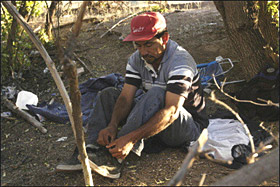 |
 |
 |
 News Around the Republic of Mexico | November 2005 News Around the Republic of Mexico | November 2005  
Mexico Smugglers' Village Booming on US Border
 Tim Gaynor - Reuters Tim Gaynor - Reuters


| | Illegal immigrant ties his shoes on the US side of the border while he waits to hop a freight train to take him further into the country. Republican lawmakers have introduced a bill to build a 2,000 mile wall along the US border with Mexico to keep illegal immigrants out. (AFP/Nicholas Roberts) |
For decades, residents of this Mexican desert village on the border with the United States baked bricks and ranched cattle to make a meager living. Sasabe was barren and isolated then.

Now it is a boomtown studded with bars, flophouses and taco stands as that isolation has made it a popular and thriving hub for smugglers hauling undocumented migrants north into America, authorities say.

The U.S. Border Patrol said more than 165,000 illegal immigrants were picked up last year in a scrub- and cactus-strewn corridor near this sun-baked community, nearly an eighth of the total 1.2 million arrested for the whole 2,000-mile (3,200-km) Mexican border.

A crackdown on security in the border cities of San Diego, California, to the west and Nogales, Arizona, to the east in recent years has forced immigrants to seek more out-of-the way spots like Sasabe to sneak across the border.

Each afternoon hundreds of weary looking travelers, many hefting gallon jugs of water for the journey ahead, gather on benches outside cheap restaurants in Sasabe as they wait to cross into Arizona, led by guides dubbed "polleros" or "coyotes."

"It all started when the U.S. authorities closed the border around the cities, and people started to cross in the most inhospitable areas," town administrator Jose Alejandro Leyva said in the one-story office building he shares with the community's three police officers.

"At one time there were no undocumented migrants here ... and now the town is growing out of control ... driven by the influx of migrants passing through here on their way north," he added.

Border Boomtown

Two coyotes, dressed like immigrants in well-worn jeans, T-shirts and baseball caps so as to blend in if nabbed by U.S. border police after crossing into the United States, bluntly refused to be interviewed for this story and accused the reporter of being a policeman.

Mexican state migrant welfare organization Grupo Beta estimates up to 1,000 people - mainly from poverty-wracked southern states such as Veracruz, Oaxaca and Chiapas - stream north through Sasabe each day headed for the United States either on foot or in trucks.

The village has doubled in size to some 4,000 people in just four years as a result, with criminals and entrepreneurs from across Mexico flocking in to make money on the back of the illicit cross-border trade.

The most obvious beneficiaries are the coyotes, who earn a fat cut from fees of up to $2,000 that U.S. border police say immigrants must pay to be taken over the border and north to Arizona cities Tucson and Phoenix.

The money is spent building new cinder-block homes in the dusty village, as well as on things like late-model pickup trucks, many of which are fitted with tinted windows. These trucks ride the dusty main street blaring out thumping accordion ballads.

Secondary businesses have also sprung up to cater to the migrants including general stores, flophouse hotels that charge just $3 a night, as well as restaurants and cantinas - one cheekily named 'El Coyote' by its owners.

Locals say many businesses have been set up by people from outside the community to take advantage of the easy money, including one cook from the eastern state of Veracruz who opened a taco stall early in October.

"We figured there was a chance to make something out of the passing trade," cook Mariano Oliver said as he stirred a vat of simmering ox bones for a group of migrants in his dirt-floor diner.

A Dangerous Business

The trade can be deadly. The U.S. Border Patrol in Tucson said 145 migrants died in the year to October crossing the western desert area that includes Sasabe. Most perished of dehydration during the brutal summer heat.

The cross-border trade also has a downside for Sasabe and surrounding areas, as cinder-block buildings are thrown up regardless of planning regulations, and added demand is placed on already hard-pressed water supplies, Leyva said.

Some ranchers near the town also complained that immigrants snip through the five-strand barbed wire border fence marking the northern limit of their land, letting their cattle out to roam into the United States.

Sasabe's namesake twin just across the cactus-studded border in Arizona, has also been marked by the migration, as pristine desert trails are littered with empty water bottles, plastic bags and discarded clothing.

Residents say the roadway through the tiny village, which includes a primary school and a general store, has become a racetrack as Border Patrol units chase after smugglers fleeing back to Mexico in vans packed with migrants.

"One time they were going so fast through here that they spun off the road at the hairpin bend and through a neighbor's wall," said long-suffering store owner Deborah Grider.

"We have a school here, and we are very concerned that someone could get killed," she added. | 
 | |
 |



